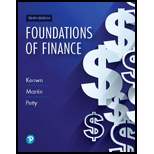
Foundations Of Finance
10th Edition
ISBN: 9780134897264
Author: KEOWN, Arthur J., Martin, John D., PETTY, J. William
Publisher: Pearson,
expand_more
expand_more
format_list_bulleted
Textbook Question
Chapter 5, Problem 55SP
(Complex
- a. How much must you deposit annually to accumulate this amount?
- b. If you decide to make a large lump-sum deposit today instead of the annual deposits, how large should this lump-sum deposit be? (Assume you can earn 7 percent on this deposit.)
- c. At the end of 5 years you will receive $10,000 and deposit this in the bank toward your goal of $50,000 at the end of 15 years. In addition to this deposit, how much must you deposit in equal annual deposits to reach your goal? (Again assume you can earn 7 percent on this deposit.)
Expert Solution & Answer
Want to see the full answer?
Check out a sample textbook solution
Students have asked these similar questions
How do companies evaluate the feasibility of a project using NPV and IRR?
What are derivatives, and how are they used in hedging?
What are index funds, and why are they popular among long-term investors in finance?
Chapter 5 Solutions
Foundations Of Finance
Ch. 5 - Prob. 1RQCh. 5 - The processes of discounting and compounding are...Ch. 5 - Prob. 3RQCh. 5 - Prob. 4RQCh. 5 - Prob. 5RQCh. 5 - Prob. 1SPCh. 5 - Prob. 2SPCh. 5 - Prob. 3SPCh. 5 - Prob. 4SPCh. 5 - Prob. 5SP
Ch. 5 - (Compound value) Stanford Simmons, who recently...Ch. 5 - (Future value) Sarah Wiggum would like to make a...Ch. 5 - Prob. 8SPCh. 5 - (Future value) Giancarlo Stanton hit 59 home runs...Ch. 5 - Prob. 10SPCh. 5 - Prob. 11SPCh. 5 - Prob. 12SPCh. 5 - Prob. 13SPCh. 5 - Prob. 14SPCh. 5 - Prob. 15SPCh. 5 - Prob. 16SPCh. 5 - Prob. 17SPCh. 5 - Prob. 18SPCh. 5 - Prob. 19SPCh. 5 - Prob. 20SPCh. 5 - Prob. 21SPCh. 5 - Prob. 22SPCh. 5 - Prob. 23SPCh. 5 - Prob. 24SPCh. 5 - (Solving for PMT of an annuity) To pay for your...Ch. 5 - Prob. 26SPCh. 5 - Prob. 27SPCh. 5 - (Loan amortization) On December 31, Beth Klemkosky...Ch. 5 - (Solving for r of an annuity) You lend a friend...Ch. 5 - Prob. 30SPCh. 5 - (Compound annuity) You plan on buying some...Ch. 5 - (Loan amortization) On December 31, Son-Nan Chen...Ch. 5 - (Loan amortization) To buy a new house you must...Ch. 5 - Prob. 34SPCh. 5 - Prob. 35SPCh. 5 - Prob. 36SPCh. 5 - Prob. 37SPCh. 5 - Prob. 38SPCh. 5 - (Compound interest uith nonannnal periods) a....Ch. 5 - (Compound interest with nonannual periods) After...Ch. 5 - Prob. 41SPCh. 5 - (Spreadsheet problem) To buy a new house you take...Ch. 5 - (Nonannual compounding using a calculator) Jesse...Ch. 5 - (Nonannual compounding using a calculator)...Ch. 5 - (Nonannual compounding using a calculator) Fords...Ch. 5 - Prob. 46SPCh. 5 - (Nonannual compounding using a calculator) Dennis...Ch. 5 - Prob. 48SPCh. 5 - (Calculating the effective annual rate) Youve just...Ch. 5 - Prob. 50SPCh. 5 - Prob. 51SPCh. 5 - (Present value) The Kumar Corporation is planning...Ch. 5 - (Perpetuities) What is the present value of the...Ch. 5 - (Complex present value) How much do you have to...Ch. 5 - (Complex present value) You would like to have...Ch. 5 - Prob. 56SPCh. 5 - Prob. 57SPCh. 5 - Prob. 58SPCh. 5 - Prob. 59SPCh. 5 - (Present value of a complex stream) Don Draper has...Ch. 5 - (Present value of a complex stream) Don Draper has...Ch. 5 - (Complex stream of cash flows) Roger Sterling has...Ch. 5 - (Future and present value using a calculator) In...Ch. 5 - Prob. 1MCCh. 5 - Prob. 2MCCh. 5 - Prob. 3MCCh. 5 - Prob. 4MCCh. 5 - Prob. 5MCCh. 5 - Prob. 6MCCh. 5 - Prob. 7MCCh. 5 - Prob. 8MCCh. 5 - Prob. 9MCCh. 5 - Prob. 10MCCh. 5 - Prob. 11MC
Knowledge Booster
Learn more about
Need a deep-dive on the concept behind this application? Look no further. Learn more about this topic, finance and related others by exploring similar questions and additional content below.Similar questions
arrow_back_ios
SEE MORE QUESTIONS
arrow_forward_ios
Recommended textbooks for you
- Principles of Accounting Volume 2AccountingISBN:9781947172609Author:OpenStaxPublisher:OpenStax College

 Pfin (with Mindtap, 1 Term Printed Access Card) (...FinanceISBN:9780357033609Author:Randall Billingsley, Lawrence J. Gitman, Michael D. JoehnkPublisher:Cengage Learning
Pfin (with Mindtap, 1 Term Printed Access Card) (...FinanceISBN:9780357033609Author:Randall Billingsley, Lawrence J. Gitman, Michael D. JoehnkPublisher:Cengage Learning EBK CONTEMPORARY FINANCIAL MANAGEMENTFinanceISBN:9781337514835Author:MOYERPublisher:CENGAGE LEARNING - CONSIGNMENT
EBK CONTEMPORARY FINANCIAL MANAGEMENTFinanceISBN:9781337514835Author:MOYERPublisher:CENGAGE LEARNING - CONSIGNMENT

Principles of Accounting Volume 2
Accounting
ISBN:9781947172609
Author:OpenStax
Publisher:OpenStax College



Pfin (with Mindtap, 1 Term Printed Access Card) (...
Finance
ISBN:9780357033609
Author:Randall Billingsley, Lawrence J. Gitman, Michael D. Joehnk
Publisher:Cengage Learning

EBK CONTEMPORARY FINANCIAL MANAGEMENT
Finance
ISBN:9781337514835
Author:MOYER
Publisher:CENGAGE LEARNING - CONSIGNMENT

How To Calculate The Present Value of an Annuity; Author: The Organic Chemistry Tutor;https://www.youtube.com/watch?v=RU-osjAs6hE;License: Standard Youtube License